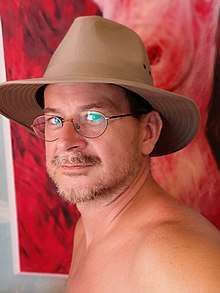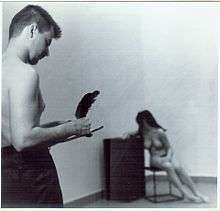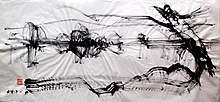Alfred Freddy Krupa
Alfred Freddy Krupa (Krūppa) GCCR[3] (14 June 1971, Karlovac, Yugoslavia) is a Croatian contemporary painter, master draughtsman, book artist, art photographer and art teacher.[4][5][6][7][8][9] Multidisciplinary artist Alfred Freddy Krupa is considered a pioneering force and the western proponent in the New Ink Art movement, for which he has gained international recognition.[10][11]
Alfred Freddy Krupa | |
|---|---|
 Alfred Freddy Krupa | |
| Born | Alfred Krupa 14 June 1971 Karlovac, Yugoslavia |
| Nationality | Croatian |
| Education | Academy of Fine Arts, University of Zagreb, Tokyo Gakugei University, Croatian State Institute for Education |
| Known for | Painting, Drawing, Artists Books, Art Theory |
Notable work | "Roots - Korijeni"[1] |
| Movement | Modern European ink painting Informalism, Postminimalism, Neo-figurative art, Contemporary realism |
| Spouse(s) | Ljiljana Krupa |
| Children | Gabriel Alfred Krupa, Eleonora Krupa |
| Awards | »Councillor Special Prize« at the 3rd International Exhibition of the Chinese Calligraphy and Ink Painting, Anshan (China), Medal Marshal Trompowsky, Matto Grosso do Sul (Brasil), Croatian Association of Artists Zagreb Annual Award for 2016 (Croatia) and many others[2] |

.jpg)

.jpg)

Family background
Alfred Freddy Krupa comes from a multiethnic Silesian family of long tradition in visual arts.[12] His family appears in archives of the International Tracing Service as the registered victims of Nazi persecution.[13] His grandfather and first mentor Alfred Krupa Sr.[14][15][16](Alfred Joseph Kruppa,[17] Mikolow, Poland 1915 - Karlovac, Croatia/Yugoslavia 1989, related to the Oppenheim family [18]) the former pupil of Józef Mehoffer was one of the 13 core artists of the Art of Croatian Antifascist Movement[19] (he exhibited at the historic first Partisan exhibition held in Topusko in 1944 on the free territory of Yugoslavia) [20] and founder of the Watercolor Biennal of Yugoslavia (BAJ,1979).[21] His son Mladen Krupa created the portable metal steel bunker called Kruppa-M91 used during Croatian Homeland War, now under Croatian state protection.[22] According to the Eupedia[23] Krupa belongs to the rare Ashkenazi branch of haplogroup Q and through that paternal lineage is related to J. Robert Oppenheimer, Vilna Gaon, Henry Heimlich, Tony Kushner, Anson Williams, Nicky Oppenheimer, the Piątkowski h. Pomian family and other notables.
Education
Krupa graduated in 1995[24] at the Academy of Fine Arts, University of Zagreb (est. 1907 as the Royal College for Arts and Crafts (Croatian: Kraljevsko zemaljsko više obrazovalište za umjetnost i umjetni obrt). Krupa also studied Art History (non-degree research) at the University of Zagreb (1997,1998) and in 1998/99 as the postgraduate research student (The Monbukagakusho Scholarship (文部科学省奨学金, Monbukagakushō Shōgakukin)) at the Tokyo Gakugei University (東京学芸大学) or Gakudai (学大). In 2005 Krupa finished additional art education study and has been given formal permanent title of "Professor of Drawing and Painting" by the Croatian State Institute for Education (today "Education and Teacher Training Agency"- ETTA/AZOO)[25]
Artwork
Krupas work has attracted public and professional attention from the beginning. For the first time his name was introduced to the general public in 1990 at the then mega-popular Yugoslav weekly[26] "Vikend/Weekend".[27] In the same year his first solo exhibition was held.[28]
Since the early 1990s A.F. Krupa exhibited frequently. His works has been presented on multiple occasions together with artists such as Edo Murtić, Miroslav Šutej, Ivan Kožarić, Marijan Jevšovar, Mersad Berber, Đuro Seder, Ana Sladetić, Marino Tartaglia, Josip Vaništa,[29] Vlaho Bukovac, Bela Čikoš Sesija, Dario Ortiz, Liu Yi[30] and many others. Artfacts.net Global Artists Historical Ranking (all media) positioned A. F. Krupa around the 1300th place in 1997 based on the international exhibition history, with the similar rank for around 2 decades and in the TOP 10 Modern Ink painters (the list published on 22/02/2019).[31][32][33][34][35][36]
Internationally Krupa is known as a painter of portraits, so among other things, he portrayed Croatian President Franjo Tudjman (1996) and Rwandan King Kigeli V. (2013).
Significant/exquisite are his ink paintings, on rice paper using the technique Hakubyou. Krupa also enters into contemporary interpretation of Haboku (破墨) and Hatsuboku (溌墨)[37] and concentrates on essential and represents a simplified stylistic motifs.[38]
This visible/non-visible choice demonstrates, in effect, the strong productivity of Krupa at the level of deep and symbolic significance.[39]
Krupa, the creator of New Ink Art Manifesto, is considered the pivotal figure in Western New Ink Art movement [40]. In the Manifesto Krupa describes his ink painting as an interpretation of western modern art with the means of East Asian ink technique, as a combination of contemporary painting and traditional Chinese-Japanese calligraphy. [41]
His work in ink is considered to be of vital importance for the global integrity of the Modern ink painting,[42][43] and he is considered as one of the essential representatives of national and international present-day art, in particular of the New Ink Movement (New Ink Art)[44][45][46][47][48] Always exploring an amalgamation of various styles, as well as weaving different connections between scientific and artistic theories, he creates ink-on-paper works that reflect a minimalist, mathematical approach. Each of Krupa's pieces are spontaneous, raw and direct, achieving a personal and authentic artistic signature.[49]
In his photographic works, Krupa demonstrates the same minimalist approach and philosophy, placing the focus on composition and contrast.[50][51]
Krupas original works on paper can be researched at Tate - London (Special Library Collection),[52] Silesian Museum in Katowice (Poland), Modern Gallery, Zagreb, Croatian Academy of Sciences and Arts – Dept. of Prints and Drawings (Zagreb, Croatia),[53] Alfredo Guati Rojo National Watercolor Museum (Museo Nacional de Acuarela Alfredo Guati Rojo)-Mexico City (Mexico), Office of the President of the Republic of Croatia (Zagreb, Croatia) and other public, corporate and private collections.
According to the Badan Rynkowych Institute (Warsaw) survey report from 2007 (Opinie internautów o Muzeum Sztuki Nowoczesnej w Warszawie, nagrodzonym projekcie budynku i wirtualnym Forum sztuki), Krupa appears among 70 most wanted currently working/creating artists in the future collections of the Museum of Modern Art, Warsaw (MSN).[54]
Alfred Freddy Krupa is included in the 36th edition of Who's Who in American Art and in the artist's database[55] of the documenta in Kassel. Documenta is recognized as the world's most renowned and debated international exhibition of contemporary art.
In 2016, as invited speaker Alfred F. Krupa held a rare public lecture (by a painter) on modern ink painting (and its European contribution) at the Dag Hammarskjöld University College of International Relations and Diplomacy during the Days of Japan.[56] in front of Japanese and Croatian listeners[57][58]
In 2018 Krupa has become the first living Croatian artist to be included on Ranker’s list of famous painters. Ranker is popular Los Angeles based digital media company.[59]
References
- "Modern Gallery - Zagreb Collection of Prints and Drawings) Wikimedia Commons". commons.m.wikimedia.org. Retrieved 1 April 2018.
- VisualCV.com. "Alfred Freddy Krupa - Contemporary "listed" artist - VisualCV". www.visualcv.com. Retrieved 1 April 2018.
- "Alfred Freddy Krupa Hereditary Knighthood Document". Issuu. Retrieved 1 April 2018.
- "Alfred Freddy Krupa". Allgemeines Künstlerlexikon - Internationale Künstlerdatenbank - Online.
- "ULAN Full Record Display (Getty Research)". www.getty.edu. Retrieved 1 April 2018.
- "Katalog der Deutschen Nationalbibliothek". portal.dnb.de. Retrieved 1 April 2018.
- "Muzej suvremene umjetnosti Zagreb". www.msu.hr.
- "Katalog Knjižnica grada Zagreba - Detalji". katalog.kgz.hr.
- "ALFRED FREDDY v.KRUPA (de KRŪPPA) - Master of Fine Arts (M.F.A.)/magister artium and Professor of Drawing and Painting". www.zhibit.org. Retrieved 1 April 2018.
- "Alfred Freddy Krupa". Aesthetica. Retrieved 11 August 2019.
- https://www.districtartisan.com/featured-artist-alfred-freddy-krupa/
- Europeana.eu
- "Prilozi čitatelja: Hildegard Marie ili zatvorenica broj 9772".
- http://vocab.getty.edu/page/ulan/500355816
- https://www.wikidata.org/wiki/Q55521527
- "Muzej suvremene umjetnosti Zagreb". www.msu.hr. Retrieved 1 April 2018.
- https://issuu.com/alfredfreddykrupa/docs/akrupaidartist
- "www.facebook.com/notes/alfred-freddy-krupa/mosche-moses-oppenheim-opp..."
- "Izložba umjetnika partizana, Zagreb 1945". Bibliofil. Retrieved 14 April 2020.
- "Willkommen". opac.albertina.at. Retrieved 1 April 2018.
- https://www.youtube.com/watch?v=b-NPzhfg1oY
- https://hr.wikipedia.org/wiki/Kruppa-M91
- Famous members of haplogroup Q https://www.eupedia.com/europe/Haplogroup_Q_Y-DNA.shtml#famous_people
- "ALU Alumni List".
- "ETTA description".
- Yugoslavia's Sunny Side: A History of Tourism in Socialism (1950s-1980s) https://books.google.co.uk/books?id=74GQBFB8G4MC&pg=PA330&lpg=PA330&dq=vikend+yugoslav+magazine&source=bl&ots=0hNQlgvX82&sig=LQR5sAIegRYSC_IZaQAKKEHzUSA&hl=en&sa=X&ved=0ahUKEwi6v6CgitbbAhWEFZoKHfyGBOYQ6AEITTAJ#v=onepage&q=vikend%20yugoslav%20magazine&f=false
- Yugoslavian magazine "Vikend": Alfred (Freddy) Krupa (1990) https://issuu.com/alfredfreddykrupa/docs/32785072_10215991405755622_55728895
- Večernji List (Evening Newspaper): Krupini crteži / Krupas drawings (1990) https://issuu.com/alfredfreddykrupa/docs/gradska_stra_a
- https://www.moma.org/artists/41131?locale=en
- https://www.widewalls.ch/artist/liu-yi/
- https://artfacts.net/movement/_/189
- https://artfacts.net/artist/alfred-freddy-krupa/544333
- https://www.facebook.com/alfred.f.krupa/posts/10216336135933661
- http://www.hdlu.hr/2016/01/izlozba-skupna-izlozba-od-bukovca-do-dolica-u-centru-cvjetni/
- http://portal53.hr/treci-petrinjski-salon-grafike-pokupske-graficke-mape/
- https://www.facebook.com/iwscroatia/posts/d41d8cd9/583054708553170/
- System, Japanese Architecture and Art Net Users. "JAANUS / hakubyou 白描". www.aisf.or.jp.
- Dr. Andreas Beyer, Dr. Bénédicte Savoy, Dr. Wolf Tegethoff (Hrsg.), ALLGEMEINES KÜNSTLERLEXIKON (AKL) Die Bildenden Künstler aller Zeiten und Völker (The visual artists of all times and peoples), band/volume 82 (ISBN 9783110231878), De Gruyter-Berlin, 2014
- Arte Al Limite ed.83 (Chile) pg. 58-63 https://issuu.com/arteallimite/docs/83_pags
- https://medium.com/predict/new-ink-art-movement-the-rising-popularity-of-contemporary-ink-painting-b6bf7c831ba5
- S. Stolz, 20.12.2019, The Allgemeines Kunstlerlexikon - World Biographical Dictionary of Artists ONLINE
- European Library: Monograph Alfred Freddy Krupa (ISBN 9789537167455, authors Zvonimir Gerber, Casey Shannon, Ransui Yakata, Višnja Lasić)
- Virtual Library of Slovenia
- https://en.wikiversity.org/wiki/Modern_European_Ink_Painting
- "The Institute of Modern Art Nuremberg/Institut für moderne Kunst Nürnberg". Archived from the original on 3 March 2016. Retrieved 25 February 2016.
- "Arte Al Limite: Reduction to deepening".
- https://www.wikiart.org/en/artists-by-art-movement/new-ink-art#!#resultType:masonry
- https://www.wikiart.org/en/alfred-freddy-krupa
- https://www.mutualart.com/Artist/Alfred-Freddy-Krupa/92EED427EBC15EEE/Biography
- "He switched the painting knowledge into the photo" https://issuu.com/europeanglobalart/docs/20988828_10213633143880549_81517114
- "Alfred Freddy Krupa - 627 artworks - painting". www.wikiart.org. Retrieved 14 April 2020.
- "If search returns no hits, display browse". library.tate.org.uk.
- "Krupa in Croatian Academy of Sciences and Art-Graphic Art Dpt. Collection (in Croatian)". Archived from the original on 3 January 2015.
- Badan Rynkowich Institute of Warsaw Report(in Polish)
- documenta (archiv) artists database-Alfred Freddy Krupa http://alephino.documentaarchiv.de/alipac/CGBMMVSMVRGAKKZWEIRU-00016/sysfull?BASE=B-ART&IDN=26267
- Croatian-Japanese Center https://blog.dnevnik.hr/hrvatskojapanskicentar/oznaka/dani-japana?page=blog&tag=dani-japana&subpage=0&subdomain=hrvatskojapanskicentar
- https://www.facebook.com/pg/Studentski.zbor.VSMODDH/photos/?tab=album&album_id=735411943261376
- Akademija Art News https://akademija-art.hr/art/izlobe-sp-208/izlozba-i-predavanje-a-f-krupe-na-danima-japana-na-visokoj-skoli-medunarodnih-odnosa-i-diplomacije-dag-hammarskjoeld/
- "First living Croatian artist included on Ranker's list of famous painters". Croatia Week. Retrieved 14 April 2020.
External links


- Alfred Freddy Krupa at WikiArt
- Alfred Freddy Krupa at Deutsche Fotothek (German photo library)
- Alfred Freddy Krupa at Getty Images
- Alfred Freddy Krupa at Monoskop
- Alfred Freddy Krupa in the Collection of the Karlovac City Museum (GMK)
- Alfred Freddy Krupa at YouTube
- Alfred Freddy Krupa at ScienceOpen
- Alfred Freddy Krupa at arthistoricum.net
- Alfred Freddy Krupa at Artland